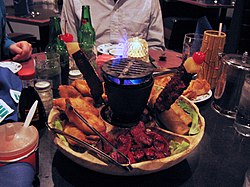Pu pu platter
 | |
| Course | Hors d'oeuvre |
|---|---|
| Main ingredients | Meat and seafood |
| Pu pu platter | |
|---|---|
Hanyu Pinyin | bǎobǎo pán |
| Yue: Cantonese | |
| Yale Romanization | bou2 bou2 pun4 |
| Jyutping | bou2 bou2 pun4 |
A pu pu platter is a tray of American Chinese or Hawaiian food[1] consisting of an assortment of small meat and seafood appetizers. The Thrillist called the pu-pu platter "an amalgam of Americanized Chinese food, Hawaiian tradition and bar food."[2]
The pupu platter was probably first introduced to restaurants on the United States mainland by Donn Beach in 1934.[1] It has since become a standard at most Polynesian-themed restaurants such as Don's and Trader Vic's.[3][4] The earliest known print reference to a pupu platter served at a Chinese restaurant is from 1969.[5] Later, other types of restaurants used "pu pu platter" to describe an appetizer combination platter.[n 1]
However, pu pu platters are currently more closely associated with American Chinese restaurants.
Hawaiian origin and etymology
In the Hawaiian language, pū-pū denotes a relish, appetizer, canapé, or hors d'oeuvre; it originally meant "shell fish', but also referred to small bits of fish, chicken, or banana relish served with kava[8] and beans.
In Hawaiian cuisine
This section needs additional citations for verification. (May 2021) |
Since the introduction of commercial dining and drinking establishments in Hawaii, pūpū were, and remain, standard fare in island establishments., and vegetables. Some establishments will serve pūpū to the table.
At Hawaiian bars, restaurants, catered events such as political rallies, and private parties, establishments and hosts are known in "local" circles by the quality of their pupus. Event invitations often will state that "light pupus" or "heavy pupus" will be served so that attendees will know whether they should plan to have a full meal before the event or not.
In Polynesian cuisine on the mainland
At the height of the
Always the showman, Trader Vic included a hibachi grill when presenting a pu pu platter at the table.[9] Others say that the idea could have come from Donn Beach.[12] No one can agree, but everyone else appeared to have copied the idea.
By the twenty-first century, the tiki bars and the flaming pu pu platter had become a dying art. Some tiki bar aficionados have created lists of tiki bars in the United States in which a flaming pu pu can still be found.[13][14]
At one 21st-century tiki bar, the pu pu platter includes "Samoan deviled eggs, Chinese sausage and stick[y] rice arancini, coconut shrimp and chilies stuffed with pork sausage."
In Italian restaurants
Italian restaurants in New England may offer "Italian pu pu platters". Depending on the establishment, the platters may contain only appetizers, such as mozzarella sticks, meatballs, sausages, lasagna sticks, and calamari;[16] or they may contain small portions of different pasta dishes, such as spaghetti, lasagna, manicotti, and ravioli.[17][18][19]
See also
Notes
References
- ^ a b Hartz, Deborah S. (July 9, 2003). "Carrying a torch for pupu platters". Chicago Tribune. Archived from the original on 2014-07-14. Retrieved 2016-02-28.
- ^ a b Mancall-Bitel, Nicholas (August 22, 2016). "The Anatomy of a Pu-Pu Platter, the World's Greatest Bar Snack". Thrillist. Archived from the original on March 19, 2022. Retrieved March 19, 2022.
- from the original on July 8, 2017. Retrieved February 18, 2017.
- ProQuest 236842977.
- ProQuest 118613566.
35, Sun Ming, Huntington. Cantonese Cuisine. Flaming Pu Pu Platter. Our House Banquet Dinner. Op. 7 days for lunch, din. & cocktails. Private room parties. Free park. Amer. Exp., Din. Club. 2 miles W. of Rte. 110 Jericho Tpke. & Round Swamp Rd.
- ^ O'Leary, Joanna (March 10, 2014). "A Brief History of the Pu Pu Platter". Houston Press. Archived from the original on 2014-11-29.
- ^ Yeh, Cedric (September 23, 2010). "Pu pu platters versus birthday cakes". O Say Can You See?. National Museum of American History. Archived from the original on September 30, 2010. Retrieved February 28, 2016.
- University of Hawaii Press. Retrieved November 15, 2010.
- ^ ProQuest 1337906294.
- ProQuest 114303967.
- ProQuest 1324081035.
- ^ Glass, Jeremy. "Who Invented the Tiki Bar? A Brief (and Controversial) History". Men's Journal. Archived from the original on 2021-12-30. Retrieved 2022-03-19.
- ^ Trott, Michelle "Humuhumu" (September 16, 2016). "These Tiki Bars Are Keeping Flaming Pu Pus Alive". Critiki. Archived from the original on May 24, 2022. Retrieved May 24, 2022.
- ^ Trott, Michelle "Humuhumu" (September 15, 2016). "The Dying Art of the Flaming Pu-Pu Platter". Critiki. Archived from the original on June 27, 2022. Retrieved May 24, 2022.
- New York Times. Archivedfrom the original on February 8, 2024. Retrieved June 25, 2022.
- Boston Globe. Archivedfrom the original on July 27, 2021. Retrieved July 27, 2021.
- ^ Bonner, Michael (February 1, 2018). "Dine Out: Cafe Roma feels like 'home'". The Herald News.
- ^ "Phantom Gourmet: Mike's Restaurant In Fairhaven". WBZ-TV. January 10, 2017. Archived from the original on July 27, 2021. Retrieved July 27, 2021.
- ^ Comey, Jonathan (November 21, 2013). "Jonathan Comey - Dine Out: Cafe Roma gets Italian food right". The Standard-Times (New Bedford). Archived from the original on July 27, 2021. Retrieved July 27, 2021.
